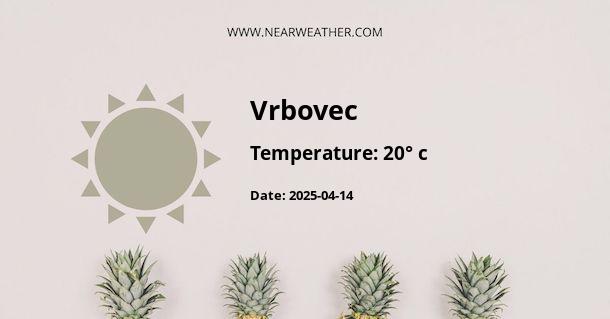Understanding the Climate and Weather of Vrbovec, Croatia
Located in the continental part of Croatia, Vrbovec boasts a climate that is characterized by its continental traits. This results in warm summers and cold winters, a pattern typical for regions situated away from large bodies of water. To comprehend the climate nuances of Vrbovec, we will delve into various aspects such as temperature averages, precipitation patterns, and notable weather events that shape the overall climate profile of this picturesque Croatian town.
Seasonal Overview
Vrbovec experiences a temperate continental climate, with four distinct seasons that bring diversity in weather conditions throughout the year. This climatic type is classified under the Köppen climate classification as "Cfb" — where 'C' signifies a temperate climate, 'f' denotes no dry season with significant precipitation in all months, and 'b' indicates the warmest month's average temperature is below 22°C (71.6°F).
Temperature Extremes
Throughout the year, temperatures can vary considerably. Winters are typically cold with average temperatures often dropping below freezing. On the other hand, summers are generally warm, sometimes hot, with temperatures frequently climbing above 25°C (77°F). The highest and lowest temperatures recorded in the area give us a snapshot of the temperature extremes that Vrbovec can experience.
Temperature Record Chart for Vrbovec, HR
----------------------------------------
| Month | High (°C) | Low (°C) |
|------------|-------------|-------------|
| January | 8 | -23 |
| February | 17 | -19 |
| March | 22 | -16 |
| April | 28 | -3 |
| May | 33 | 0 |
| June | 35 | 3 |
| July | 38 | 6 |
| August | 37 | 5 |
| September | 30 | -2 |
| October | 25 | -6 |
| November | 19 | -12 |
| December | 15 | -20 |
----------------------------------------
Average Monthly Temperatures and Precipitation
January and February typically hold the coldest days in Vrbovec, where snow and ice can become a common occurrence. As we transition into March and April, the snow melts away, paving the path for more temperate conditions, albeit still with a high probability of frost.
When May rolls around, spring is in full bloom and temperatures begin to climb, providing a pleasing warmth that transitions into the heat of June, July, and August. These summer months often see the mercury rise, creating peak conditions for outdoor activities.
Once September and October arrive, the temperatures again start to cool down, bringing back sweater weather as autumn sets in. November sees a further temperature drop, which then leads us into the chilly ambiance of December.
| Month | Av. High (°C) | Av. Low (°C) | Avg. Precipitation (mm) |
|---|---|---|---|
| January | 2 | -5 | 40 |
| February | 5 | -3 | 35 |
| March | 10 | 0 | 50 |
| April | 16 | 5 | 55 |
| May | 21 | 10 | 70 |
| June | 24 | 13 | 75 |
| July | 26 | 15 | 80 |
| August | 26 | 14 | 80 |
| September | 21 | 10 | 85 |
| October | 15 | 6 | 70 |
| November | 9 | 1 | 80 |
| December | 3 | -3 | 50 |
Precipitation Patterns
The distribution of precipitation in Vrbovec is relatively even throughout the year, with a slight increase during the warmer months when convective storms are more likely to occur. The table above offers a monthly breakdown of average precipitation, providing insight into the wetter and drier periods of the year.
Wind and Weather Phenomena
Winds in Vrbovec are generally mild, with occasional stronger gusts during stormy conditions. Due to its inland location, the area does not experience the coastal "bura" wind common in other parts of Croatia. Weather phenomena such as fog and hoar frost can occur in the colder months, while summer might bring thunderstorms and, although infrequent, hail.
“Vrbovec, with its continental climate, offers a diverse weather palette that ranges from serene snowy winters to vibrant warm summers, making it a destination for seasons' admirers.”
Impact of Climate Change
Vrbovec, like many other regions, is not immune to the impacts of climate change. Observations suggest alterations in precipitation patterns and an increase in frequency of extreme weather events. This evolving climate landscape necessitates continuous monitoring and potentially adapting local agricultural practices, a crucial aspect of Vrbovec's economy.
Best Time to Visit
- Summer (June - August): Ideal for outdoor enthusiasts looking to enjoy warm weather activities.
- Autumn (September - October): Perfect for those who prefer cooler temperatures and fewer tourists, with the added bonus of autumnal landscapes.
- Winter (December - February): Suitable for visitors eager to experience a classic continental winter, perhaps with a chance of snow.
- Spring (March - May): Appeals to sightseers wishing to witness the awakening of nature and pleasantly mild weather.
Conclusion
In summary, Vrbovec's weather creates an environment where each season distinctively shapes the town's character. Whether one seeks the cozy winter chill, the lush verdure of spring, the sun-drenched expanses of summer, or the rustic charm of autumn, Vrbovec's climate caters to a broad spectrum of preferences. Keeping in mind the potential changes brought by global climate shifts, both local residents and visitors alike need to remain conscious of seasonal variations and the impacts they may have on the region's natural and cultural heritage.
Note: All temperature and precipitation values mentioned herein are based on historical averages and are subject to change due to the dynamic nature of weather and climate.
A - Vrbovec's Latitude is 45.883331 & Longitude is 16.421671.
A - Weather in Vrbovec is 8° today.
A - Climate Conditions in Vrbovec shows overcast clouds today.
A - Humidity in Vrbovec is 80% today.
A - Wind speed in Vrbovec is 7.42 km/h, flowing at 50° wind direction. today.
